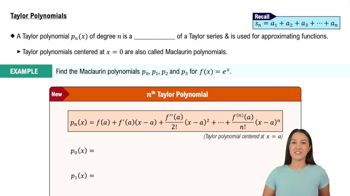Use the graph of in the figure to find the following values or state that they do not exist. <IMAGE>
Table of contents
- 0. Functions7h 54m
- Introduction to Functions16m
- Piecewise Functions10m
- Properties of Functions9m
- Common Functions1h 8m
- Transformations5m
- Combining Functions27m
- Exponent rules32m
- Exponential Functions28m
- Logarithmic Functions24m
- Properties of Logarithms36m
- Exponential & Logarithmic Equations35m
- Introduction to Trigonometric Functions38m
- Graphs of Trigonometric Functions44m
- Trigonometric Identities47m
- Inverse Trigonometric Functions48m
- 1. Limits and Continuity2h 2m
- 2. Intro to Derivatives1h 33m
- 3. Techniques of Differentiation3h 18m
- 4. Applications of Derivatives2h 38m
- 5. Graphical Applications of Derivatives6h 2m
- 6. Derivatives of Inverse, Exponential, & Logarithmic Functions2h 37m
- 7. Antiderivatives & Indefinite Integrals1h 26m
- 8. Definite Integrals4h 44m
- 9. Graphical Applications of Integrals2h 27m
- 10. Physics Applications of Integrals 3h 16m
- 11. Integrals of Inverse, Exponential, & Logarithmic Functions2h 31m
- 12. Techniques of Integration7h 41m
- 13. Intro to Differential Equations2h 55m
- 14. Sequences & Series5h 36m
- 15. Power Series2h 19m
- 16. Parametric Equations & Polar Coordinates7h 58m
1. Limits and Continuity
Introduction to Limits
Problem 7b
Textbook Question
Let f(x)=x−2x2−4. <IMAGE>
Make a conjecture about the value of x→2limx−2x2−4.
 Verified step by step guidance
Verified step by step guidance1
First, recognize that the expression \( \frac{x^2 - 4}{x - 2} \) is undefined at \( x = 2 \) because it results in division by zero. Therefore, we need to simplify the expression to evaluate the limit.
Notice that the numerator \( x^2 - 4 \) can be factored as a difference of squares: \( x^2 - 4 = (x - 2)(x + 2) \).
Substitute the factored form into the original expression: \( \frac{(x - 2)(x + 2)}{x - 2} \).
Cancel the common factor \( (x - 2) \) in the numerator and the denominator, which simplifies the expression to \( x + 2 \), provided \( x \neq 2 \).
Now, evaluate the limit of the simplified expression as \( x \to 2 \): \( \lim_{x \to 2} (x + 2) \). This can be directly computed by substituting \( x = 2 \) into the expression, leading to the conjecture about the limit.
 Verified video answer for a similar problem:
Verified video answer for a similar problem:This video solution was recommended by our tutors as helpful for the problem above
Video duration:
2mPlay a video:
Was this helpful?
Key Concepts
Here are the essential concepts you must grasp in order to answer the question correctly.
Limits
A limit is a fundamental concept in calculus that describes the behavior of a function as its input approaches a certain value. It helps in understanding the function's behavior near points where it may not be explicitly defined, such as points of discontinuity. In this question, we are interested in the limit of the function as x approaches 2, which is crucial for evaluating the function's value at that point.
Recommended video:

One-Sided Limits
Factoring Polynomials
Factoring polynomials involves rewriting a polynomial as a product of simpler polynomials or expressions. In the given function, f(x) = (x^2 - 4)/(x - 2), the numerator can be factored as (x - 2)(x + 2). This simplification is essential for evaluating the limit, as it allows us to cancel out the common factor in the numerator and denominator, making the limit easier to compute.
Recommended video:

Taylor Polynomials
Continuity
Continuity refers to a function being unbroken or having no gaps at a certain point. A function is continuous at a point if the limit as x approaches that point equals the function's value at that point. In this case, understanding continuity is important because it helps us determine whether the limit we compute will yield a valid function value at x = 2, which is initially undefined in the original function.
Recommended video:

Intro to Continuity

 6:47m
6:47mWatch next
Master Finding Limits Numerically and Graphically with a bite sized video explanation from Patrick
Start learningRelated Videos
Related Practice
Textbook Question
